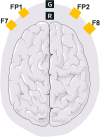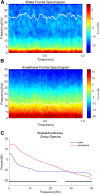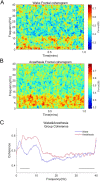Electroencephalographic dynamics of etomidate-induced loss of consciousness
- PMID: 33832426
- PMCID: PMC8028814
- DOI: 10.1186/s12871-021-01308-7
Electroencephalographic dynamics of etomidate-induced loss of consciousness
Abstract
Background: Highly structured electroencephalography (EEG) oscillations can occur in adults during etomidate-induced general anesthesia, but the link between these two phenomena is poorly understood. Therefore, in the present study, we investigated the electroencephalogram dynamics of etomidate-induced loss of consciousness (LOC) in order to understand the neurological mechanism of etomidate-induced LOC.
Methods: This study is a prospective observational study. Etomidate-induced anesthesia was performed on eligible patients undergoing elective surgery. We analyzed EEG data from 20 patients who received etomidate for the induction of general anesthesia. We used power spectra and coherence methods to process and analyze the EEG data. Our study was based on 4-channel EEG recordings.
Results: Compared with the baseline (awake period), etomidate induced an increase in power in delta, theta, alpha and beta waves during LOC. Compared with the awake period, the delta-wave (1-4 Hz), alpha-wave(8-13 Hz), and theta-wave(4-8 Hz) coherence increased significantly during LOC, while the slow-wave (< 1 Hz) coherence decreased. However, the delta wave (1.0-4.0 Hz) during etomidate-induced LOC was more coherent than during the awake period (1.86-3.17 Hz, two-group test for coherence, p < 0.001).
Conclusions: The neural circuit mechanism of etomidate-induced LOC is closely related to the induction of oscillation in delta, theta, alpha and beta waves and the enhancement of delta-wave coherence.
Trial registration: ChiCTR1800017110.
Keywords: EEG; Etomidate; General anesthesia; LOC.
Conflict of interest statement
The authors declare that they have no competing interests.
Figures





References
-
- Gooding. JM, Weng. J-T, Smith. RA, Berninger. GT, Kirby. RR. Cardiovascular and Pulmonary, Responses following Etomidate Induction of Anesthesia in Patients with Demonstrated Cardiac Disease. Anesth Analg. 1979;58:40–1. - PubMed
-
- Hamme. MJV, M.M.Ghoneim., J.Ambre. J. Pharmacokinetics of Etomidate,a New Intravenous Anesthetic. Anesthesiology. 1978;49:274–7. - PubMed
Publication types
MeSH terms
Substances
LinkOut - more resources
Full Text Sources
Other Literature Sources

